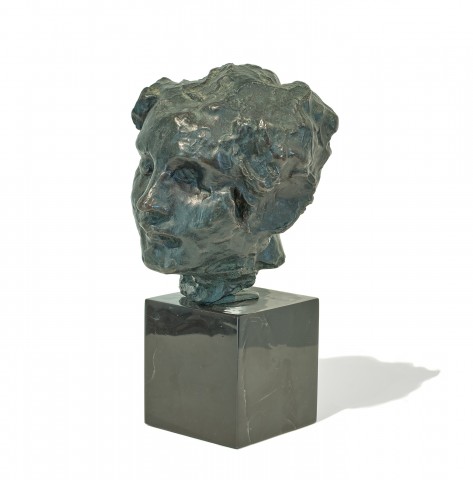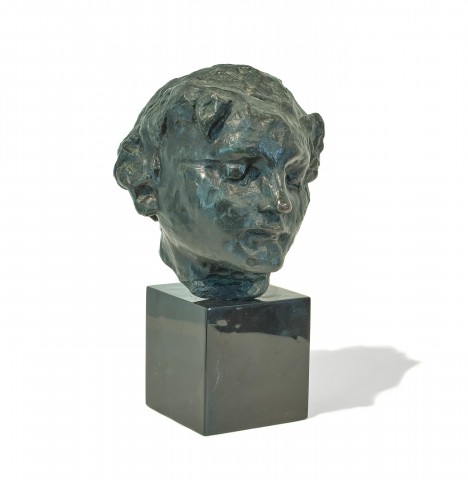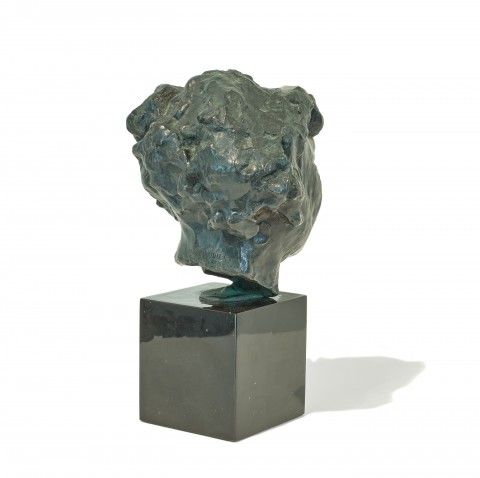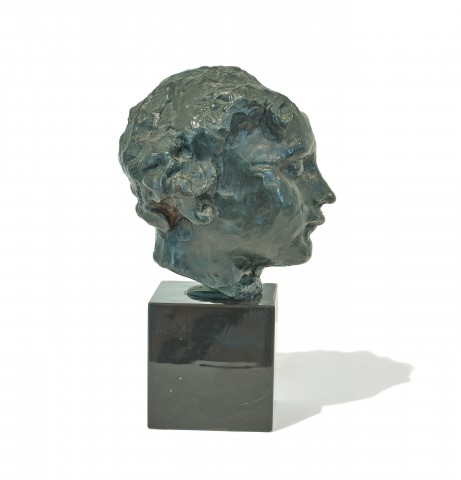TÊTE DE GÉNIE FUNÉRAIRE (HEAD OF A FUNERARY SPIRIT), c.1898 – 99
AUGUSTE RODIN
cast c.1920s
bronze
15.0 cm height
signed at base: A. Rodin
bears foundry stamp at base: Alexis RUDIER. / Fondeur. PARIS.
also known as TÊTE DE GÉNIE DU REPOS ÉTERNEL/TÊTE No. 33
Curt Valentin Gallery, New York
Joseph H. Hirshhorn, New York, acquired from the above in 1955
Hirshhorn Museum and Sculpture Garden, Washington D.C., a bequest from the above in 1966
Christie’s, New York, 18 February 1988, lot 1
Holland Fine Art, Sydney, acquired from the above
Private collection, Sydney, acquired from the above in 1989
Rodin, Curt Valentin Gallery, New York, 4 – 29 May 1954, cat. 7 (illus. in exhibition catalogue, as ‘spirit of Melancholy’)
Sculpture in Our Time. Collected by Joseph H. Hirshhorn, The Detroit Institute of Arts, Michigan, 5 May - 23 August 1959, cat. 38 (as ‘Spirit of Melancholy, 1898’)
Modern Sculpture from the Joseph H. Hirshhorn Collection, Solomon R. Guggenheim Museum, New York, 3 October 1962 - 6 January 1963, cat. 395 (as ‘Spirit of Melancholy, 1898’)
Artist and Maecenas: A Tribute to Curt Valentin, Marlborough-Gerson Gallery, New York, November - December 1963, cat. 7 (illus. in exhibition catalogue)
Grappe, G., Catalogue du Musée Rodin, Paris, 1927, cat. 240, pp. 87 - 88 (illus., another cast)
Grappe, G., Catalogue du Musée Rodin, Paris, 1929, cat. 274, pp. 105 - 106, (illus., another cast)
Watkins, G. F., Rodin Museum of Philadelphia, Pennsylvania, 1929, cat. 73, p. 20 (as ‘Head of a Funeral Spirit’)
Grappe, G., Catalogue du Musée Rodin, Paris, 1931, cat. 323, p. 127, (illus., another cast)
Grappe, G., Catalogue du Musée Rodin, Paris, 1938, cat. 259, p. 100 (illus., another cast)
Grappe, G., Catalogue du Musée Rodin, Paris, 1944, cat. 292 bis, p. 100 (illus., another cast)
Tancock, J. L., Rodin Museum: Handbook, Philadelphia Museum of Art, Pennsylvania, 1969, cat. 109
Tancock, J. L., The Sculpture of Auguste Rodin: The Collection of the Rodin Museum, David R. Godine in association with Philadelphia Museum of Art, Pennsylvania, 1976, cat. 118, pp. 613-614, 615 (illus., another cast, 1899)
Le Normand-Romain, A., The Bronzes of Rodin, Catalogue of Works in the Musée Rodin, Musée Rodin / Editions de la Réunion des musées nationaux, Paris, 2007, vol. I, pp. 394 - 398 (as ‘Funerary Spirit, Head, 1898’), vol. II, cat. S. 652, p. 395 (illus., another cast, c.1898)
Rodin sculpture.jpg
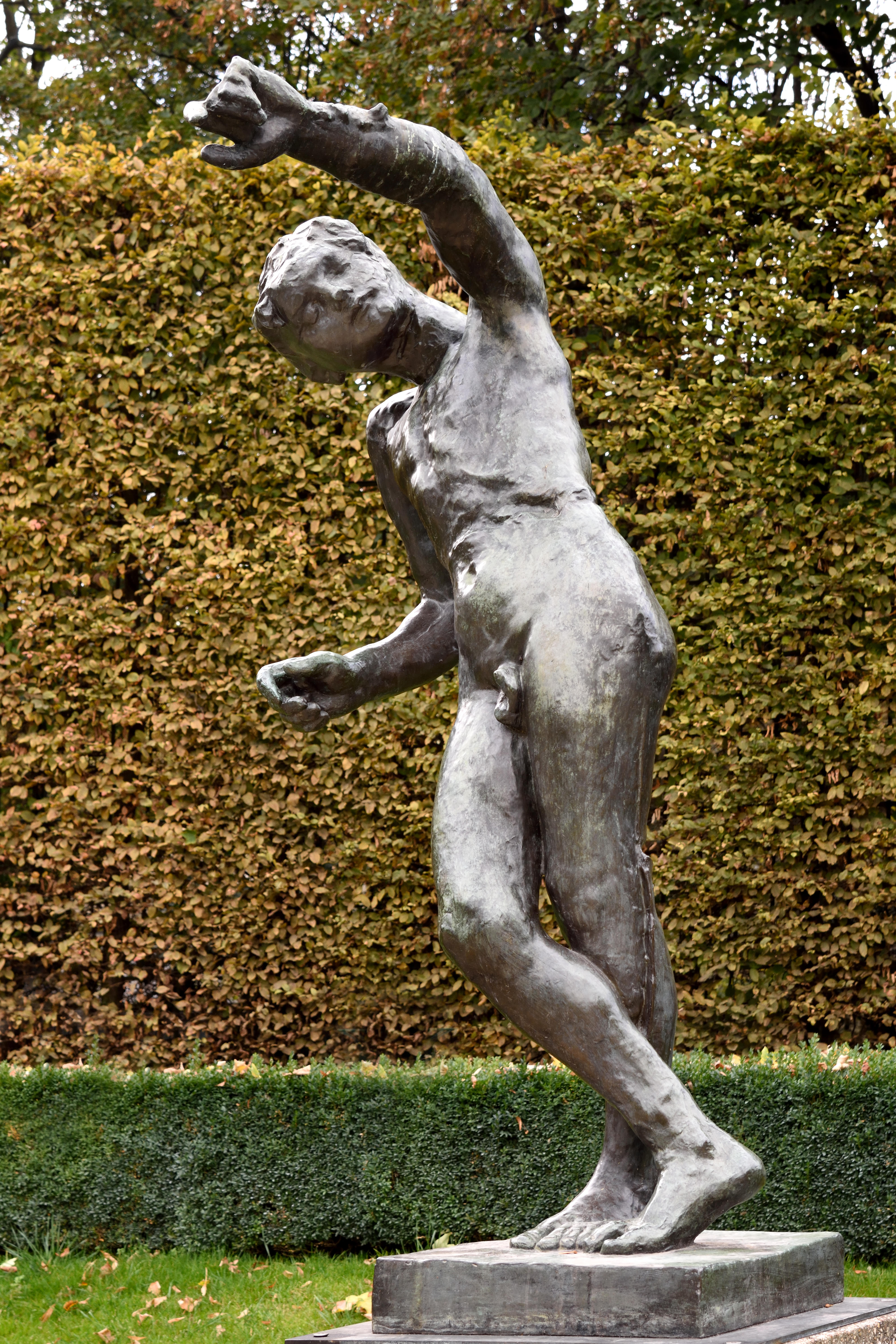
Auguste Rodin was the most influential sculptor of the 19th century, and by 1900, the date of his first solo exhibition, had reached the pinnacle of his career. Although his modern expressive style was far removed from the classical traditions of statuary, from 1880 – 1900 Rodin’s sculptural expertise was highly sought-after by the French state and by professional associations.1 The works resulting from these frequent commissions for public monuments became many of Rodin’s most famous works: The Gates of Hell (1880 – c.1890); The Burghers of Calais (1884 – 1889); Monument to Victor Hugo (1889 – 1897); and the Monument to Balzac (1892 – 97). This solemn and intimate sculpture of a young man’s head, Tête de Génie Funéraire, cast in bronze, relates to two plaster figures of the Génie du Repos Éternel (The Spirit of Eternal Repose).2 This allegorical portrait was included in Rodin’s commissioned maquette for a state monument for the recently departed French painter, Pierre Puvis de Chavannes (1824 – 1898). The Maître Puvis, like Rodin, was a major artistic figure of the Third Republic, a close friend and admired artistic peer. Although commissioned on 24 March 1899 and the maquette completed around 19053, the monument itself was never realised, and an alternative version was instead constructed by Jules Desbois and inaugurated in 1924.
Instead of a portrait bust, this is the head of a male allegorical figure, an idealised Greek youth embodying the ‘funerary spirit.’ A personification of mournfulness, an expression of the transience of life and conferring glory on the deceased, this Dionysian figure was common in the sculpture of antiquity, with a popular resurgence during the Florentine Renaissance. With aquiline features and a rough halo of hair, the spirit has its eyes closed in a poignant and respectful expression of reflection. The bronze cast has retained the expressive quality of Rodin’s informal modelling of plaster, conveying with immediacy the emotive power of his figure.
The complete plaster maquette of the Puvis de Chavannes Monument (Musée Rodin, Paris) displays the full extent of the sculptor’s radical installation, and reveals the Hellenic influences the sculptor included to honour his friend’s classicism. Hastily constructed from pre-existing sculptures, Rodin’s humble monument featured a bust of Puvis he had made in 1891 atop a column of two superimposed architectural capitals (one doric and one Corinthian), placed on a table. Next to this static arrangement is an allegorical scene with the life-sized génie, in cross-legged contrapposto, leaning over to pick an apple from a sprawling sapling cast from life. Rodin described this work in a letter in 1909: ‘composed like a painting by Puvis, with voids and holes – it must let green shine though in the interstices.’4 The Spirit of Eternal Repose was based on a Roman statue in the Louvre Museum, Hypnos or Génie du Repos Éternel. Tellingly, the English artist Gwen John, Rodin’s paramour during this same period, also drew the sculpture from the Louvre’s collections – her drawing is now held in the Amgueddfa Cymru/ Museum Wales.
Re-writing-Rodin_02-768x571.jpeg
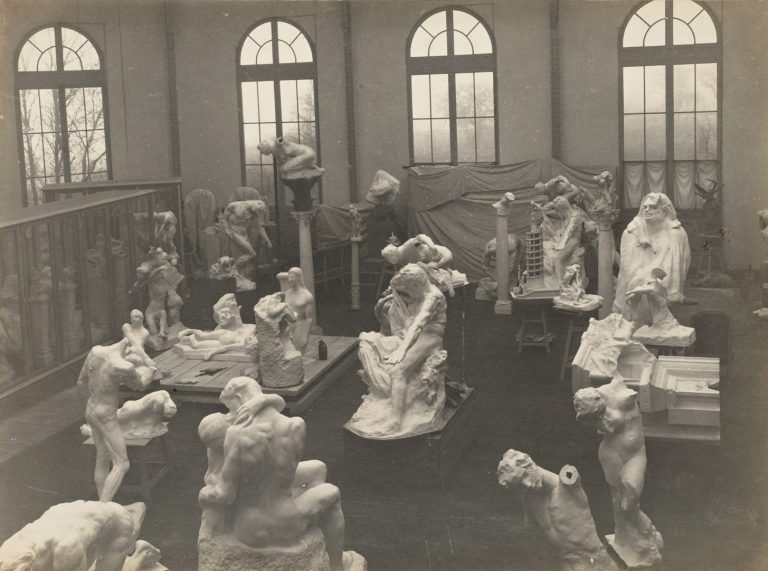
While the ‘intimate, gentle, and pure’5 monument was never fully realised in marble as intended, several of its individual elements and studies were individually cast during Rodin’s lifetime and afterwards by his estate, using the same founders and ateliers that he had approved of to carry out his artistic vision to the highest integrity. Rodin considered the Puvis monument one of his finest realisations, reportedly commenting on it in his last breath.6 This early bronze cast of the Génie Funéraire was purchased by the great American mining magnate, collector and philanthropist, Joseph H. Hirshhorn. Having amassed an extraordinary collection of 19th and 20th century art in the post-war years, Hirshhorn made a vast donation of works to American government in 1966, resulting in the establishment of the Hirshhorn Museum and Sculpture Garden in Washington D.C., however crucially accompanied by a liberal deaccession policy. Between May 1986 – December 1988, the museum sold at auction 365 works over 46 auctions held by Christie’s and Sotheby’s7, rationalising the collection to allow for contemporary acquisitions. This Tête de Génie Funéraire was purchased directly from one of these divestment auctions, in December 1988, thus retaining its impeccable provenance.
1. Eisen, A., Rodin, Secker & Warburg, London, 1974, p. 67
2. The Spirit of Eternal Repose, c.1898 (195.5 cm height), the full-length plaster figure with head and no arms was exhibited at the Rodin exhibition in Brussels in 1900, as was a reduced version of the figure, from which it is suggested that the Head of a Funerary Spirit was cast in bronze. See Tancock, J. L., The Sculpture of Auguste Rodin, Philadelphia Museum of Art, 1976, cat. 118, pp. 613 – 615
3. Mauclair, C., Rodin: The Man – His Ideas – His Works, Duckworth & Co., London, 1905, p. 89
4. Letter to H. Durand-Tahier, 24 June 1909, cited in ‘Monument a Pierre Puvis de Chavannes’, A Nos Grands Hommes, Musée d’Orsay, see https://anosgrandshommes.museeorsay.fr/index.php/Detail/objects/5459 (accessed March 2024)
5. Mauclair, ibid., p. 90
6. Vilain, J. et al., Rodin: At the Musée Rodin, Editions Scala, Paris, 1999, p. 68
7. Tully, J., ‘Hishhorn Sells 23 Works for $500,000’, Washington Post, 1 December 1988
LUCIE REEVES-SMITH

